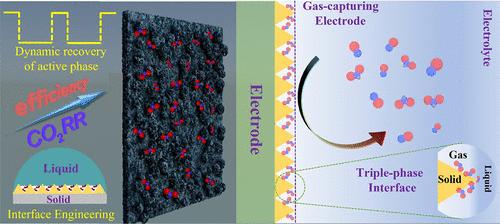当前位置:
X-MOL 学术
›
J. Am. Chem. Soc.
›
论文详情
Our official English website, www.x-mol.net, welcomes your feedback! (Note: you will need to create a separate account there.)
Dynamic Bubbling Balanced Proactive CO2 Capture and Reduction on a Triple-Phase Interface Nanoporous Electrocatalyst
Journal of the American Chemical Society ( IF 14.4 ) Pub Date : 2024-07-24 , DOI: 10.1021/jacs.4c02786 Wei Zhang 1, 2 , Ao Yu 1 , Haiyan Mao 3, 4 , Guangxia Feng 5 , Cheng Li 6, 7 , Guanzhi Wang 1, 2 , Jinfa Chang 1, 8 , David Halat 4 , Zhao Li 1, 2 , Weilai Yu 3 , Yaping Shi 5 , Shengwen Liu 1 , David W. Fox 1, 9 , Hao Zhuang 4 , Angela Cai 3 , Bing Wu 4 , Fnu Joshua 1 , John R. Martinez 9 , Lei Zhai 1, 9 , M. Danny Gu 6 , Xiaonan Shan 5 , Jeffrey A. Reimer 4, 10 , Yi Cui 3 , Yang Yang 1, 2, 9, 11, 12
Journal of the American Chemical Society ( IF 14.4 ) Pub Date : 2024-07-24 , DOI: 10.1021/jacs.4c02786 Wei Zhang 1, 2 , Ao Yu 1 , Haiyan Mao 3, 4 , Guangxia Feng 5 , Cheng Li 6, 7 , Guanzhi Wang 1, 2 , Jinfa Chang 1, 8 , David Halat 4 , Zhao Li 1, 2 , Weilai Yu 3 , Yaping Shi 5 , Shengwen Liu 1 , David W. Fox 1, 9 , Hao Zhuang 4 , Angela Cai 3 , Bing Wu 4 , Fnu Joshua 1 , John R. Martinez 9 , Lei Zhai 1, 9 , M. Danny Gu 6 , Xiaonan Shan 5 , Jeffrey A. Reimer 4, 10 , Yi Cui 3 , Yang Yang 1, 2, 9, 11, 12
Affiliation

|
The formation and preservation of the active phase of the catalysts at the triple-phase interface during CO2 capture and reduction is essential for improving the conversion efficiency of CO2 electroreduction toward value-added chemicals and fuels under operational conditions. Designing such ideal catalysts that can mitigate parasitic hydrogen generation and prevent active phase degradation during the CO2 reduction reaction (CO2RR), however, remains a significant challenge. Herein, we developed an interfacial engineering strategy to build a new SnOx catalyst by invoking multiscale approaches. This catalyst features a hierarchically nanoporous structure coated with an organic F-monolayer that modifies the triple-phase interface in aqueous electrolytes, substantially reducing competing hydrogen generation (less than 5%) and enhancing CO2RR selectivity (∼90%). This rationally designed triple-phase interface overcomes the issue of limited CO2 solubility in aqueous electrolytes via proactive CO2 capture and reduction. Concurrently, we utilized pulsed square-wave potentials to dynamically recover the active phase for the CO2RR to regulate the production of C1 products such as formate and carbon monoxide (CO). This protocol ensures profoundly enhanced CO2RR selectivity (∼90%) compared with constant potential (∼70%) applied at −0.8 V (V vs RHE). We further achieved a mechanistic understanding of the CO2 capture and reduction processes under pulsed square-wave potentials via in situ Raman spectroscopy, thereby observing the potential-dependent intensity of Raman vibrational modes of the active phase and CO2RR intermediates. This work will inspire material design strategies by leveraging triple-phase interface engineering for emerging electrochemical processes, as technology moves toward electrification and decarbonization.
中文翻译:

三相界面纳米多孔电催化剂上的动态鼓泡平衡主动 CO2 捕获和还原
CO 2 捕获和还原过程中三相界面催化剂活性相的形成和保存对于提高CO 2 电还原向增值的转化效率至关重要操作条件下的化学品和燃料。然而,设计这种能够减轻寄生氢生成并防止 CO 2 还原反应 (CO 2 RR) 期间活性相降解的理想催化剂仍然是一个重大挑战。在此,我们开发了一种界面工程策略,通过调用多尺度方法构建新型 SnO x 催化剂。该催化剂具有分层纳米多孔结构,涂有有机 F-单层,可改变水性电解质中的三相界面,显着减少竞争性氢气生成(低于 5%)并提高 CO 2 RR 选择性(∼ 90%)。这种合理设计的三相界面通过主动捕获和还原 CO 2 克服了 CO 2 在水性电解质中溶解度有限的问题。同时,我们利用脉冲方波电势动态恢复 CO 2 RR 的活性相,以调节甲酸盐和一氧化碳 (CO) 等 C1 产品的生产。与在−0.8 V(V vs RHE)下施加的恒定电势(∼70%)相比,该协议可确保大幅增强CO 2 RR选择性(∼90%)。我们通过原位拉曼光谱进一步实现了对脉冲方波电位下CO 2 捕获和还原过程的机理理解,从而观察了活性相和CO<的拉曼振动模式的电位依赖性强度。 b11> RR中间体。 随着技术向电气化和脱碳方向发展,这项工作将通过利用新兴电化学过程的三相界面工程来激发材料设计策略。
更新日期:2024-07-25
中文翻译:

三相界面纳米多孔电催化剂上的动态鼓泡平衡主动 CO2 捕获和还原
CO 2 捕获和还原过程中三相界面催化剂活性相的形成和保存对于提高CO 2 电还原向增值的转化效率至关重要操作条件下的化学品和燃料。然而,设计这种能够减轻寄生氢生成并防止 CO 2 还原反应 (CO 2 RR) 期间活性相降解的理想催化剂仍然是一个重大挑战。在此,我们开发了一种界面工程策略,通过调用多尺度方法构建新型 SnO x 催化剂。该催化剂具有分层纳米多孔结构,涂有有机 F-单层,可改变水性电解质中的三相界面,显着减少竞争性氢气生成(低于 5%)并提高 CO 2 RR 选择性(∼ 90%)。这种合理设计的三相界面通过主动捕获和还原 CO 2 克服了 CO 2 在水性电解质中溶解度有限的问题。同时,我们利用脉冲方波电势动态恢复 CO 2 RR 的活性相,以调节甲酸盐和一氧化碳 (CO) 等 C1 产品的生产。与在−0.8 V(V vs RHE)下施加的恒定电势(∼70%)相比,该协议可确保大幅增强CO 2 RR选择性(∼90%)。我们通过原位拉曼光谱进一步实现了对脉冲方波电位下CO 2 捕获和还原过程的机理理解,从而观察了活性相和CO<的拉曼振动模式的电位依赖性强度。 b11> RR中间体。 随着技术向电气化和脱碳方向发展,这项工作将通过利用新兴电化学过程的三相界面工程来激发材料设计策略。












































 京公网安备 11010802027423号
京公网安备 11010802027423号